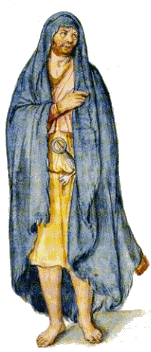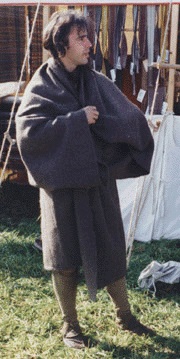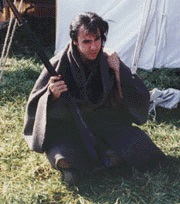|
-
7th November 21, 06:19 PM
#1
Belted Kilt questions
I am very new to kilts. I own 2 modern kilts, an US Air Force and McLaren. I got into kilts dude to a scottish buddy. My closest and only scottish relative was a great Grandma from Fife named Low. Research told me Low is the McLaren tartan but as lowlanders does it matter. Anyway on to my question. I want to explore the great or belted kilt. I want to use it as a blanket on my bed in winter, use it camping/hunting for warmth. As well as maybe for some ren fairs. So would a great/belted kilt work for this? Would I ruin it leaving it on my bed during winter? Also which tartan the McLaren for my family or US Air Force as I am retired. Thanks for the help.
-
-
7th November 21, 07:06 PM
#2
I have used lengths of woollen fabric as bedding when camping and as long as you have a clear bed space it should be fine.
I wash the bedding in the bath on returning home and get it clean and dry before it is stored away. Even the year when all three lots of bedding were saturated by the time I returned home, the experience did no damage.
Wool is able to absorb moisture and still feel warm, so even when I arrived back in camp wet though I slept warm and dry.
I do not use the fabric as a great kilt though, I much prefer a small kilt and plaid.
Having made myself a great kilt I found that in a modern setting it caught on everything, door and drawer handles in particular. It swept things off shelves and was very quickly converted into a dressing gown.
Perhaps it is just me, but I can't quite square the idea of a great kilt and an air force tartan. It seems such an anachronism. I feel it ought to be a simple plaid pattern twill weave fabric as even a named tartan seems too modern.
Anne the Pleater
I presume to dictate to no man what he shall eat or drink or wherewithal he shall be clothed."
-- The Hon. Stuart Ruaidri Erskine, The Kilt & How to Wear It, 1901.
-
The Following 3 Users say 'Aye' to Pleater For This Useful Post:
-
7th November 21, 07:14 PM
#3
 Originally Posted by Pleater

Anne the Pleater
I understand your view using a very modern tartan with an ancient garment is a bit off. Perhaps I'll look at others to include McLaren which I have family ties to or macduff where my family emigrated from. I also want to be able to throw it on my bed as well
-
-
8th November 21, 07:03 AM
#4
 Originally Posted by Hrafnar

I am very new to kilts. I own 2 modern kilts, an US Air Force and McLaren. I got into kilts dude to a scottish buddy. My closest and only scottish relative was a great Grandma from Fife named Low. Research told me Low is the McLaren tartan but as lowlanders does it matter. Anyway on to my question. I want to explore the great or belted kilt. I want to use it as a blanket on my bed in winter, use it camping/hunting for warmth. As well as maybe for some ren fairs. So would a great/belted kilt work for this? Would I ruin it leaving it on my bed during winter? Also which tartan the McLaren for my family or US Air Force as I am retired. Thanks for the help.
Seems like it would be the wrong shape for a normal bed - the fabric is very long and not as wide as a blanket. For length you'd need to double it back, maybe more than once (or let it drape decoratively to the floor?). Wide enough for a twin bed (38") but it wouldn't really quite cover even a full bed (54").
Good if you're out in the woods, I should think; although as Anne the Pleater says, you have to get used to all that extra fabric.
When in doubt, end with a jig. - Robin McCauley
-
-
8th November 21, 07:32 AM
#5
I have put the fabric onto a bed doubled over with both the sewn edges down one side of the bed, the fold on the other side, when the weather turned cold and the winter weight duvet was still damp from washing. Two layers of 16oz wool are very warm.
Anne the Pleater
I presume to dictate to no man what he shall eat or drink or wherewithal he shall be clothed."
-- The Hon. Stuart Ruaidri Erskine, The Kilt & How to Wear It, 1901.
-
The Following 2 Users say 'Aye' to Pleater For This Useful Post:
-
10th November 21, 11:35 AM
#6
 Originally Posted by Hrafnar

I am very new to kilts. I own 2 modern kilts, an US Air Force and McLaren. I got into kilts dude to a scottish buddy. My closest and only scottish relative was a great Grandma from Fife named Low. Research told me Low is the McLaren tartan but as lowlanders does it matter. Anyway on to my question. I want to explore the great or belted kilt. I want to use it as a blanket on my bed in winter, use it camping/hunting for warmth. As well as maybe for some ren fairs. So would a great/belted kilt work for this? Would I ruin it leaving it on my bed during winter? Also which tartan the McLaren for my family or US Air Force as I am retired. Thanks for the help.
The belted plaid/great kilt/féileadh an bhreacáin/féileadh mór is an interesting garment. I have some videos on how I put it on (not necessarily historically accurate but it's what I tend to do) and then there are some more historically-focused videos like the ones Isaac Walters has recorded.
Here's me: https://www.youtube.com/watch?v=73IdagCYaZw&t=1s
Here's Isaac: https://www.youtube.com/watch?v=peI1LSpTVVk&t=8s
Regards,
Jonathan
-
-
11th November 21, 06:25 AM
#7
I use what I call my "Enlisted" plaid as a blanket when camping in the summer. It is a fully joined plaid of 2 pieces of single width tartan, measures aprox 60 wide by 3 yards long. It is just the right amount of blanket combined with a linen sheet when a Hudson Bay blanket is too much. Also is a great wrapper when making a midnight visit to the loo.
-
The Following User Says 'Aye' to Luke MacGillie For This Useful Post:
-
11th November 21, 10:57 AM
#8
Warning - Personal rant
I'm one of those who feel that, as there is very scant historical evidence of what a belted plaide (Gaelic for blanket) was, or how it was worn, that the Ren Faire and YouTube folks may be totally wrong.
I was at a Ren Faire a few years ago and at one booth a guy claiming to be a historic reenactor was demonstrating his interpretation.
All the while he was laying out his 27 feet (There is no historical proof where the phrase "The whole 9 yards" comes from) of single width, modern Tartan fabric, arranging the pleats just so, he kept saying how practical this garment was. He must have said it 4 times in the 15+ min it took him to put it on.
All that was going through my mind was -
Every morning when you wake up, what it the first thing you do? Is it practical to spend 15 min arranging perfect pleats just to go to the latrine?
I also noticed that a boiled wool blanket would have kept him much warmer than his modern fabric. In fact he stated, quietly as an aside, that he used two blankets in addition to his kilt fabric. One as a ground cover and one over for warmth.
I kept thinking that, as he could not really know, would another garment that we do know about, make just as much sense? There is quite a bit of historical evidence that what some call a "Matchcoat/ Bed Roll" was known and used by many cultures, going back to well before photography.
I'm sure everyone has seen similar images, of people in cultures around the world, dressed like this. Below is "L'Irlandois" by Lucas de Herre, ca. 1575.

This image is from the book "Before the Kilt" by Gerald A. John Kelly, showing the Irish Leine and Brat.

It is quite common to see images of the N. American Indigenous peoples dressed like this. The style of blankets below go back to somewhere around the 1500's and are woven double-width on a simple back strap loom in some of the most intricate, and famous, patterns.

The original Hudson's Bay Point Blanket was red. This is a white one from a little bit later, after photography. While the Hudson's Bay Company was not the first, by far, to make heavy boiled wool blankets, they did popularize them in N. America by trading hundreds of thousands of them for furs. The points denote the size and even in 1779 the 3 point (approx. double bed size) was the most common and desired.

This idea of wrapping yourself in a blanket goes back about as far as recorded history and is seen all around the world in many cultures. Below is the Thula Tule of Lesotho. Woven in England this is the National symbol of Lesotho and the patterns are as distinctive in Basotho as Tartan is to Scotland.

Heck, even women wore blankets in this way. In Scotland it is called an Arasaid. In Wales it is called a Ruana. The Arasaid below has the waist strap through a series of loops to make it easier and faster to put on.

Would it not make common sense to think that a boiled wool blanket would make a far more practical thing to wear than to assume, and try to reverse engineer, something from modern kilt fabric?
The weaving technique that allows a wide piece of fabric to be woven on a narrow loom is called "Double Weave" and has been around for longer than we have records.
And thick, heavy, wool blankets have been around as long as humans have needed something to stay warm.
(Marco Polo wrote in the 1500's, while travelling along the silk route, that they and their hosts would wrap themselves in their sleeping blankets to sit around the evening fire. Just before going to bed the hosts would throw their blankets into the fire. They were cleaning their blankets which were woven from pure asbestos.)
From the middle ages up to the turn of the 20th century this idea of sleeping while wrapped in a wool blanket is the principle behind a "bed roll". One waxed or waterproofed ground cover large enough to go both under you, to protect from the cold and damp ground, and then flipped over you to keep off rain or early morning dew. Inside the waterproofed layer you would have a blanket to keep you warm.
In the morning you got up, shook out the blanket, and wrapped it around your shoulders. Then took the belt from your Leine and put it over the blanket at the waist to hold it. You could fasten it at the neck with a penannular brooch. (A Brat)?
The waterproof ground cloth was then rolled up with all your valuables inside and slung over the shoulder with a leather strap. A rudimentary day pack.
This did not require you to lay on the damp, cold ground to put on. Simply stand and drape the blanket over your shoulders. If it is raining, drape the waterproof ground cloth over your head hanging down all around. A rain cape.

Don't worry about perfect pleats or getting the bottom right at the knee. You are looking for warmth and protection. Something to wrap up nice and snug at night. And then, in the morning a simple shake, a toss over your shoulders, and off to the latrine you go.
If the sun pops out and you get warm, just drop the upper portion off your shoulders.

When sitting around the campfire or in the fields during a hunt you are fully covered and protected.

I'm not suggesting that this is proof of what the belted plaide was or how it was worn. But it does seem to make much more practical, and documentably historical, sense than this.

Last edited by Steve Ashton; 13th November 21 at 09:22 PM.
-
The Following 6 Users say 'Aye' to Steve Ashton For This Useful Post:
-
11th November 21, 01:59 PM
#9
Steve,
This should be a sticky someplace. I'd also like your permission to put it on Kilts & Culture ... or if you would? I think you have a solid argument here. I'm fully honest and open that when I wear a belted plaid in a contemporary setting, I'm simply wearing it in a way that I like and that isn't necessarily substantiated by any historical evidence. I've been "corrected" by some that I'm not well-informed when I point out some of the very same issues you raise. Who would want to hand-pleat their garment everyday or whenever just to get going? And where would they do that? I can pleat it and get going pretty rapidly on my bed but, honestly, that's partly out of a desire to experiment and I do not think that these are the actions the people who invented the garment engaged in. In addition to your post, I think Isaac has a solid point when he points out that there could have been loops sewn into the plaid to help the wearer don the garment -- he has some evidence there from Bob Martin but also from historic images.
The folks who lay out massive quantities of modern kilting fabric on the ground all the while calling it "practical" look very silly to me.
Thanks for sharing. Solid post.
Jonathan
 Originally Posted by Steve Ashton

Warning - Personal rant
I'm one of those who feel that, as there is very scant historical evidence of what a belted plaide was, or how it was worn, that the Ren Faire folks may be totally wrong.
I was at a Ren Faire a few years ago and at one booth a guy claiming to be a historic reenactor was demonstrating his interpretation.
All the while he was laying out his 27 feet (9 yards) of single width, modern Tartan fabric, arranging the pleats just so, he kept saying how practical this garment was. He must have said it 4 times in the 15+ min it took him to put it on.
All that was going through my mind was -
Every morning when you wake up, what it the first thing you do? Is it practical to spend 15 min arranging perfect pleats just to go to the latrine?
I also noticed that a boiled wool blanket would have kept him much warmer than his modern fabric. (plaide means blanket) In fact he stated, quietly as an aside, that he used two blankets in addition to his kilt fabric. One as a ground cover and one over for warmth.
I kept thinking that, as he could not really know, would another garment that we do know about, make just as much sense? There is quite a bit of historical evidence that what some call a "matchcoat" was known and used by many cultures, going back to well before photography.
-
-
11th November 21, 02:29 PM
#10
 Originally Posted by Steve Ashton

Warning - Personal rant
All the while he was laying out his 27 feet (9 yards) of single width, modern Tartan fabric, arranging the pleats just so, he kept saying how practical this garment was. He must have said it 4 times in the 15+ min it took him to put it on.
[snip]
Don't worry about perfect pleats or getting the bottom right at the knee. You are looking for warmth and protection. Wrap up nice and snug at night. In the morning shake it out, toss it over your shoulders and off to the latrine you go.
I'm not suggesting that this is proof of what the belted plaide was or how it was worn. But it does seem to make much more practical sense than this.
There is no proof, as you say, but I'm quite confident that you are describing the origin of the "belted plaid" accurately. A couple of thoughts:
First, my observation is that it's more common among Society for Creative Anachronism folk to wear 4-5 yards of fabric. That is, nine or so yards cut in half and sewed together to make a double width. This is much more manageable - and takes a lot less time to assemble.
Second, I suspect - no proof, as I said - that the pleating was simply derived from bunching up a longer piece of fabric in the back so there was less in front. You can't bunch it up *too* much or it's uncomfortable under a belt, so you pleat it. Not carefully, at least not at first; just big simple folds. It's a matter of a couple minutes.
(And in my opinion throwing on a leine makes more sense for a trip to the latrine.)
When in doubt, end with a jig. - Robin McCauley
-
The Following User Says 'Aye' to Touchstone For This Useful Post:
 Posting Permissions
Posting Permissions
- You may not post new threads
- You may not post replies
- You may not post attachments
- You may not edit your posts
-
Forum Rules
|
|
































Bookmarks